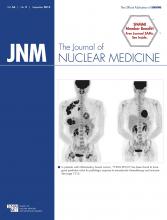REPLY: Dr. Machulla suggests modifications of tracer imaging approaches to the clinical investigation of Aβ-amyloid deposition in dementia. He suggests the potential value of two embellishments on the current clinical practice guidelines for brain amyloid imaging: imaging of skeletal muscle in addition to the brain and use of dynamic data collection with tracer kinetic analyses.
Regarding the proposed addition of skeletal muscle imaging to detect early changes in Aβ-amyloid deposition in dementia, the present understanding of pathologic amyloidosis is not encouraging. Dr. Machulla points out that Aβ deposits in skeletal muscle in inclusion body myositis (IBM) are labeled with 11C-Pittsburgh compound B (11C-PiB) as support for potential extension to suspected cases of Alzheimer disease (AD). Myopathy in IBM is known to include deposition of Aβ-amyloid (1); hence, finding increased 11C-PiB binding is not unexpected. However, myopathy (including IBM) is not characteristic of AD or other neurodegenerative dementias, even in advanced stages. Imaging of skeletal muscle to advance the diagnosis of AD is therefore not supported by the available pathologic evidence. In terms of early AD diagnosis, evidence accumulating from many laboratories indicates that Aβ-amyloid biomarkers (both PET tracer binding and cerebrospinal fluid alterations) are abnormal for years, if not decades, before dementia diagnosis (2). The addition of muscle imaging to PET brain Aβ-amyloid imaging sessions is unlikely to produce meaningful insight.
I agree with Dr. Machulla that application of compartmental tracer kinetic analysis has potential to improve the specificity of imaging. As he correctly points out, however, this approach may be difficult to accomplish on a routine clinical basis, because careful attention to subject cooperation with longer scanning sessions and more complex data reconstructions and image analyses are required. There are previously reported data demonstrating significant differences between standardized uptake value ratios and kinetically determined binding measures in AD subjects studied with 11C-PiB (3). These differences are significant in comparison to rates of change over a few years but are not as clearly important in the distinction of amyloid-positive versus -negative cross-sectional classifications.
Further development and work are needed and underway to establish automated analyses of amyloid ligand distributions that may ultimately assist clinical classification of individual subjects. Until one or more of these approaches are validated and adopted, molecular imaging experts must exercise caution in interpreting results and must be aware of the potential confounding effects of subject motion and cerebrocortical atrophy in the clinical reporting of amyloid images.
Footnotes
Published online Jul. 9, 2015.
- © 2015 by the Society of Nuclear Medicine and Molecular Imaging, Inc.







